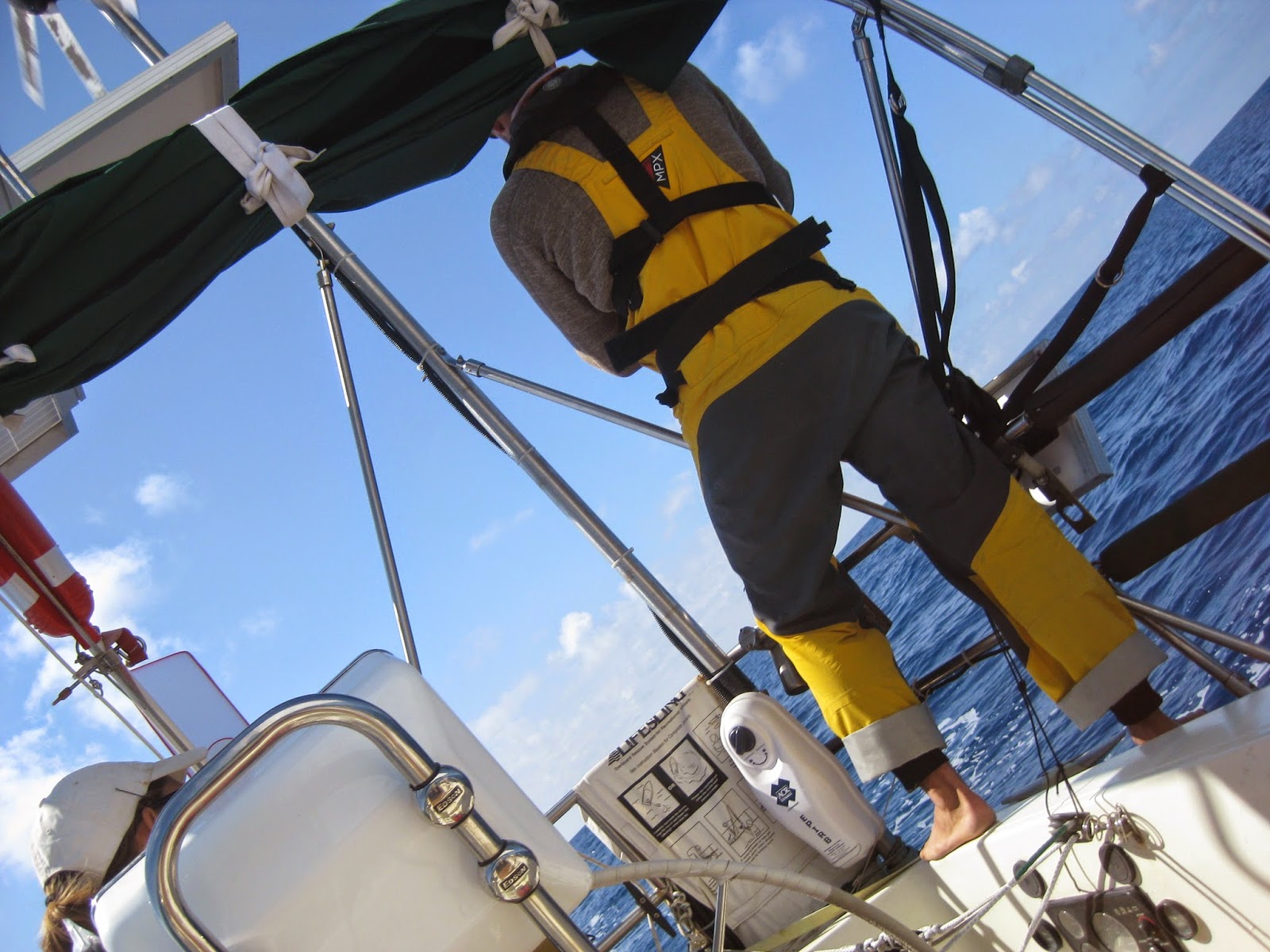I have a few pictures left over from Hawaii that I haven't posted.
First, here is a beautiful panorama (cell phones are amazing!) of the cliffs next to the marina in Menele Bay, Lana'i. We hiked up here on our way home from a relaxing day on the beach. Of course, Adam could not resist anything made of rock and hundreds of feet tall. Due to some tropical storms in the southern ocean there was a large south swell that day; the waves were crashing up against the cliffs as we climbed up to the top, making it difficult for snorkelers in the typically placid bay below us.
 |
| Lana'i (I hope the panorama works on your screen!) |
Next, here is the view of Waikiki Beach from our first night at anchor. It was difficult to anchor there because the bottom is primarily dead coral with a light sand covering but we managed to find a spot and spent the evening swimming and playing dominoes as they slid across the cockpit floor.
 |
| Waikiki: Diamond Head on the right and hotels on the left. |
While we were in Honolulu we made many new friends. We also met up with some of my old friends from college who had just been stationed there with the Navy. We took Kevin, Rachel and their two boys out sailing with us along Waikiki. At one point a pirate ship pulled up along side, started blaring what sounded like the Pirates of the Caribbean theme song and then, much to the joy of everyone on board, shot at us with its water cannons. We kept sailing in circles to go back for more!
Rachel was also incredibly kind as we prepared the boat for departure. She drove us on many of our errands and we packed her SUV to the ceiling at Costco. I think she might have a picture of that feat, but I can't seem to find it on my computer.
We actually left Hawaii at the tail end of a dying tropical storm named Wali, so unfortunately most of our time on Kauai was spent inside the cabin avoiding the rain. The rain did make for spectacular waterfalls on the cliffs and mountains surrounding Hanalei Bay, but yet again, I must have forgotten to take pictures. As you might imagine, we were a little busy making room for our new crew member and double checking just about everything before we set out to sea.
One of the most spectacular things at sea is the changes in the sky throughout the day. From the amazing sunrises to the equally colorful sunsets and all of the strange cloud formations in between, I have quite a few pictures. Here is one from our first night at sea on this most recent crossing. Of course, the colors are never quite the same on my little point and shoot camera, but you will just have to take my word for it.
If you have never seen a squall on the ocean, here is one headed right for us! It is difficult to get pictures and video during squalls or during the gale we experienced both because I do not have a waterproof camera and because sailing the boat takes priority. In our experience the weather on these crossings has been primarily calm interrupted by hours or days of stronger winds and rougher seas. Again, since I have no photos, you will just have to take my word for it.
There was only one serious injury on our second crossing: my burn. Here is a picture from about a week after the event. It still hurt but had at least scabbed over. Now, fully healed, I just have a a very white patch about the size of a band-aid.
We did a lot of fishing on both crossings, but having a third person definitely made the whole process easier. Here are a bunch of fishing pictures.
 |
| Andrew with a Mahi-Mahi (aka Dorado) |
 |
| Reeling one in |
 |
| Tuna missing a brain |
 |
| The always ready fisherman... |
 |
| That's me in there, if you can't tell. |
 |
| Adam all bundled up in his bunk. |
 |
| Cold and fog! Not very fun. |
The cold was actually my greatest fear about this whole northern crossing. I do not do well in the cold. There were a few cold days and many colder nights but most of all I remember a fun time with smooth sailing and sunshine so I will end with a few pictures of those happier times.
 |
| Adams favorite sail combination: wing-on-wing with the asymmetrical spinnaker and genoa! |
 |
| On the dock in Port Angeles as we say goodbye to Andrew in the wee hours of the morning. He had to catch a bus and we had to catch the tide. |
Thanks again to everyone following and commenting on the blog this year. We have had more than 15,300 views since September! As I said before, stay tuned. I am still not quite sure what I am going to do with the blog, but first I am going to try and figure out how to post some of the videos we took on the crossings.






